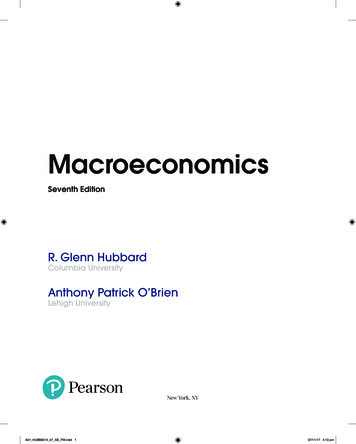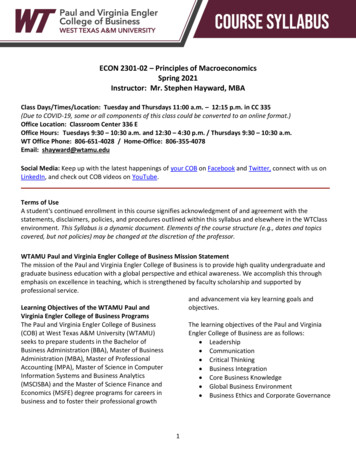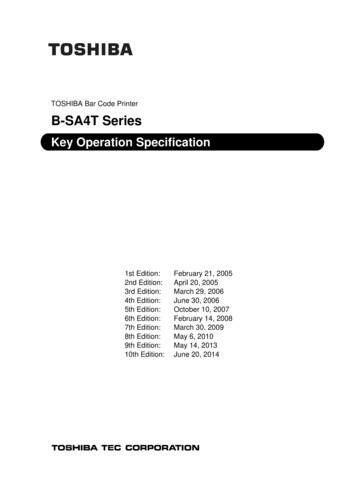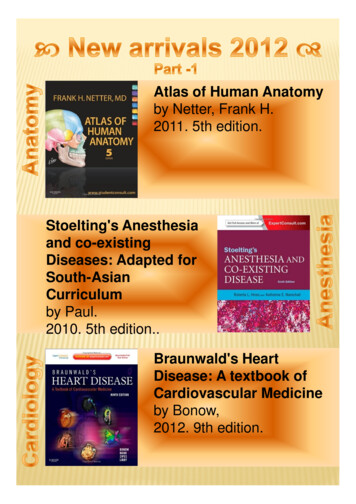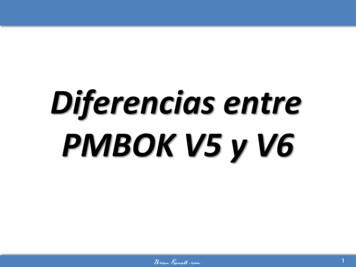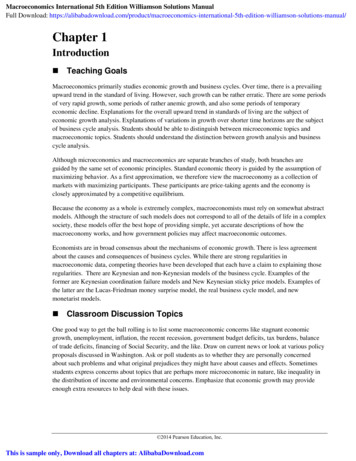
Transcription
Macroeconomics International 5th Edition Williamson Solutions ManualFull Download: nual/Chapter 1Introduction Teaching GoalsMacroeconomics primarily studies economic growth and business cycles. Over time, there is a prevailingupward trend in the standard of living. However, such growth can be rather erratic. There are some periodsof very rapid growth, some periods of rather anemic growth, and also some periods of temporaryeconomic decline. Explanations for the overall upward trend in standards of living are the subject ofeconomic growth analysis. Explanations of variations in growth over shorter time horizons are the subjectof business cycle analysis. Students should be able to distinguish between microeconomic topics andmacroeconomic topics. Students should understand the distinction between growth analysis and businesscycle analysis.Although microeconomics and macroeconomics are separate branches of study, both branches areguided by the same set of economic principles. Standard economic theory is guided by the assumption ofmaximizing behavior. As a first approximation, we therefore view the macroeconomy as a collection ofmarkets with maximizing participants. These participants are price-taking agents and the economy isclosely approximated by a competitive equilibrium.Because the economy as a whole is extremely complex, macroeconomists must rely on somewhat abstractmodels. Although the structure of such models does not correspond to all of the details of life in a complexsociety, these models offer the best hope of providing simple, yet accurate descriptions of how themacroeconomy works, and how government policies may affect macroeconomic outcomes.Economists are in broad consensus about the mechanisms of economic growth. There is less agreementabout the causes and consequences of business cycles. While there are strong regularities inmacroeconomic data, competing theories have been developed that each have a claim to explaining thoseregularities. There are Keynesian and non-Keynesian models of the business cycle. Examples of theformer are Keynesian coordination failure models and New Keynesian sticky price models. Examples ofthe latter are the Lucas-Friedman money surprise model, the real business cycle model, and newmonetarist models. Classroom Discussion TopicsOne good way to get the ball rolling is to list some macroeconomic concerns like stagnant economicgrowth, unemployment, inflation, the recent recession, government budget deficits, tax burdens, balanceof trade deficits, financing of Social Security, and the like. Draw on current news or look at various policyproposals discussed in Washington. Ask or poll students as to whether they are personally concernedabout such problems and what original prejudices they might have about causes and effects. Sometimesstudents express concerns about topics that are perhaps more microeconomic in nature, like inequality inthe distribution of income and environmental concerns. Emphasize that economic growth may provideenough extra resources to help deal with these issues. 2014 Pearson Education, Inc.This is sample only, Download all chapters at: AlibabaDownload.com
Chapter 1 Introduction2Students often have conflicting ideas about the current state of the economy. Sometimes their perspectivesmay be governed by their individual circumstances, what they read in the paper, what they see on TV andthe like. Ask them whether they believe that times are currently good or bad. Ask them why they think theway that they do. Ask them how they can more objectively back up or check out their casual impressionsabout the current state of the economy. I.II.III.IV.V.VI.VII.OutlineWhat Is Macroeconomics?Gross National Product, Economic Growth, and Business CyclesMacroeconomic ModelsMicroeconomic PrinciplesDisagreement in MacroeconomicsWhat Do We Learn from Macroeconomic Analysis?A.Fundamentals: Preferences and Productive CapacityB.The Efficiency of Market OutcomesC.The Implications of UnemploymentD.The Source of Long-run Improvements in the Standard of LivingE.A Tax Cut is not a Free LunchF.Credit MarketsG.Expectations about the FutureH.The Role of MoneyI.Business CyclesJ.International Trade in Goods and AssetsK.Money Growth and InflationL.The Phillips CurveUnderstanding Current and Recent Macroeconomic EventsA.Aggregate ProductivityB.Unemployment and VacanciesC.Taxes, Government Spending, and the Government DeficitD.InflationE.Interest RatesF.Business Cycles in the United StatesG.Credit Markets and the Financial CrisisH.The Current Account Surplus Solutions to End-of-Chapter Problems1.Calculating percentage growth rates, and log approximations to percentage growth rates, weobtain:YearPercentage Growth Rate Log Approximation2003 1.5974841.584858 2014 Pearson Education, Inc.
Chapter 1 Introduction32004 2.4666492.4367182005 2.0739922.0527782006 1.6677631.6540082007 1.1621461.1554452008 -1.13738-1.143892009 -4.41241-4.512722010 2.2572932.2321932011 0.9973770.992436In this case, calculating the change in the natural logarithm from one year to the next gives a goodapproximation to the percentage growth rate, as the growth rates are small. But if we do the same thing forgrowth rates over ten-year periods, as below, the approximation is poor, as the growth rates are relativelylarge.Ten-year percentage growth rate Log Approximation1960 19.0954417.47551970 33.1008728.593711980 22.6636220.427561990 25.3300722.578062000 23.1417520.816592.Some obvious possibilities include Federal Reserve open market purchases to keep the moneysupply from shrinking, instituting bank reforms before the Depression started, avoiding high tariffrates, etc.3.Newton’s model of falling bodies.Ignores air resistance.Works well for most dense objects, doesn’t work well for feathers.Diagrams of plays in football and basketball.Ignores the characteristics of individual players, and opponent reactions. 2014 Pearson Education, Inc.
Chapter 1 Introduction4Works well for evenly matched teams.Scale models of new aircraft designs.Ignores working engines and interior contents.Wind tunnel testing approximates aerodynamics of actual aircraft.4.The time series for unemployment exhibits an asymmetry. The unemployment rate typicallyincreases at a much higher rate than the rate at which it decreases. Thus, when theunemployment rate is unusually high, it takes a long time to fall to “normal” levels. After the2001 recession, the unemployment rate took about 7 years to fall by about 1.8 points. In 2000,the unemployment rate was 4%, and the peak unemployment rate in 2010 was about 10%.Based on previous experience, it may take until 2033 for the unemployment rate to fall to 4%.5.The deficit is large in 2011 because taxes have fallen and spending has risen. However, thecontribution of increased spending to the deficit is larger than the contribution of decreasedtaxation.6.In Figure 1.10, the money growth rate is more variable after 1980 than before 1980, but theinflation rate is more variable before 1980 than after 1980. These observations seem tocontradict the view that there is a tight link between money growth and inflation. Possibly anactive monetary policy that makes money growth more variable in the short run is necessary tomake the inflation rate stable.7.In Figure 1.12, there have been some sharp movements in the real interest rate. Before late2008, those movements in the real interest rate were due both to variability in inflation, and tovariability in the nominal interest rate. The latter movements in the nominal interest rate weredriven primarily by the Federal Reserve System. However, in late 2008, the Fed adopted a policyof essentially zero nominal interest rates, and so after late 2008, movements in the real rate aredue entirely to fluctuations in the inflation rate.8.The recent recession, in 2008-09, in figure 1.13, was more severe than the previous tworecessions, but slightly less severe than the 1981-82 recession, and about as severe as the 197475 recession. An issue here is how we determine the deviation from trend, and what the trend is.Given the way the trend is calculated here, there is a sense in which the recent recession doesnot look so bad, but that may be because of a long-term deterioration in the US economy, i.e.there was a downward level adjustment to the trend.9.When there are spikes in the interest rate spread, those tend to occur during recessions, i.e.periods when real GDP is below trend. Further, large (small) spikes in the interest rate spreadtend to be associated with large (small) negative deviations from trend in real GDP. However, inthe 1990-91 recession, there is only a small spike in the interest rate spread, which looks likeother random spikes in the spread that have occurred which are not associated with recessions.10.The three previous declines in housing prices occurred beginning in 1970, 1980, and 1990. Inthose cases, the percentage declines in relative price of housing were about 15%, 12%, and 15%, 2014 Pearson Education, Inc.
Macroeconomics International 5th Edition Williamson Solutions ManualFull Download: nual/Chapter 1 Introduction5respectively. These declines were large, but the decline beginning in 2006 was larger inpercentage terms.14.Coordination failure models and New Keynesian economic models.18.If the deficit is the result of a decrease in taxes, then there is a redistribution of the tax burden frompresent consumers to future consumers. If the deficit results from higher government spending,this usually leads to the crowding out of private spending.19.Long-run inflation is costly because it tends to reduce employment, output, and consumption.21.The period between the 1981–1982 recession and the 2008-09 financial crisis is called the GreatModeration because aggregate economic fluctuations became less volatile in this period, relativeto the 1947–1982 period.22.Asymmetric information refers to the situation where financial institutions that extend loans in thecredit market have less information about the creditworthiness of would-be borrowers than theborrowers themselves. Since lending institutions are unable to differentiate good borrowers frombad borrowers, interest rates will increase by the amount of a default premium.23.The current account surplus is net exports of goods and services (exports minus imports) plus netfactor payments (net income from abroad). The US current account surplus was positive for mostof the period 1960–1985, and it has been negative for most of the period 1985–2012. 2014 Pearson Education, Inc.This is sample only, Download all chapters at: AlibabaDownload.com
Macroeconomics primarily studies economic growth and business cycles. Over time, there is a prevailing upward trend in the standard of living. However, such growth can be rather erratic. There are some periods of very rapid growth, some periods of rather anemic gro


